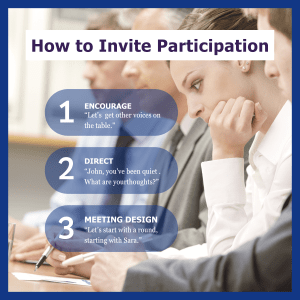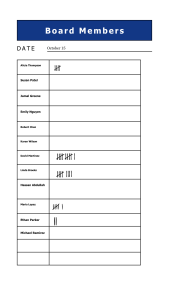
Elevate Your Nonprofit Board: How to Ensure Every Voice is Heard for Maximum Engagement
In nonprofit board meetings, engagement is key to building the kind of organization you want to lead. However, data shows that 49 percent of people are effectively silent during meetings. This means half of your nonprofit board may not be contributing fully, to the detriment of your nonprofit.
Why It Matters for Your Nonprofit:
- Missed Opportunities: Valuable ideas go unheard. For instance, Robin, usually quiet, shared a high-value idea during a breakout session that became a key part of the strategic plan—an idea that might have been missed without intentional listening.
- Compromised Wisdom: When a few voices dominate the conversation, the collective intelligence —or the combined wisdom and insights of the group— of the group sinks. Building a successful nonprofit involves creating a board that brings wisdom and resources to you—things that money can’t buy.
- Disengagement: Nonprofit board members who feel unheard may question their involvement, wondering if their limited time could be better invested elsewhere. A board member who had been courted for two years stepped down after just six months because she felt her contributions weren’t valued.
- False Buy-In: Vocal members can push through decisions, without genuine support. I’ve seen a risky decision nearly made, but when we paused to hear all voices, we discovered the majority were only slightly in favor or even neutral.
The Big Picture: Why Does Every Voice Matters for Your Nonprofit? Alignment
Ensuring that every nonprofit board member’s voice is heard is not just a meeting tactic—it’s a strategic imperative that strengthens the organization and helps achieve goals. It critical to creating effective board meetings. To move toward your vision and claim your unique place in the nonprofit market, it’s essential to build a board that genuinely supports and can help you achieve your mission. (Yes, it is possible!)
Tactics to Encourage Balanced Participation in Nonprofit Board Meetings
-
Invitations
- Encourage Participation: Both you and the board chair can actively invite quieter members to share their thoughts. Use phrases like, “We haven’t heard from everyone. Let’s slow down and get other voices on the table.”
- Direct Invitations: Address individuals directly. For example, “John, you’ve been quiet most of this meeting. What are your thoughts?”
- Meeting Design. Design your meetings to include structured rounds or other techniques where every member speaks. For instance, ‘Let’s start with Sara and go around the table.
-
Meetings Rules
Consider making these rules part of your nonprofit’s culture—board meetings and elsewhere.
- Hold Back: Similar to a family meal where parents ensure guests are served first, key board members should hold back their comments to allow others to speak. For example, encourage the executive council and governance group to adopt this mindset to improve engagement.
- No Seconds Before First. Imagine you’re at a luncheon, and people cut in line for seconds when you haven’t been served. Frustrating, right? This behavior often mirrors what happens in meetings. Establish meeting rules that ensure everyone gets a chance to speak before anyone speaks a second time.
You can change your meetings participation level by prompting people to remember that everyone one hasn’t had a chance to speak. Being intentional about calling it out the need to listen to others will increase participation by 10 percent or more. Why? Even well intentioned people forget others when they’re engaged! (Conducting virtual meetings? Here are nine ways to engage your nonprofit board.)
-
Meeting Monitors
- Track Participation: Designate a meeting monitor to track participation and report mid-meeting on who hasn’t spoken
- Meeting Checks: Have the monitor report mid-meeting on who hasn’t shared. The chair might say, “Tom, could you let us know who has spoken and who we should hear from next?”
Hint
Pro Tip: Ask quieter nonprofit board members privately if something is holding them back from speaking up. You might hear something like this, “Sue told a new member that the best new members listened their first year.” This turned out not be true. It was just what Sue was told when she joined the board.
Conclusion
Implement these tactics to see a noticeable improvement in your nonprofit board’s engagement and outcomes. Using them, you can achieve participation rates in the 90 percent range.
I’m Karen Eber Davis. Subscribe to Karen’s CEO Solutions for more insights on optimizing your nonprofit leadership and board dynamics directly in your inbox.
Karen Eber Davis is a nonprofit strategic planning consultant who works with visionary leaders committed to taking their organizations to new heights. She offers customized strategies, assessments, and coaching designed to help leaders lead their organizations to achieve their potential. She is the author of 7 Nonprofit Income Streams and Let's Raise Nonprofit Millions Together.
Categories
If you appreciate these Added Value posts, please consider subscribing.
Latest Posts
- The Uncertainty Vortex: How Visionary Nonprofit Leaders Move Forward Without Clarity
- How New Nonprofit CEOs Secure Board Buy-In for Strategic Planning
- How Nonprofit Leader Navigate Crisis with Clarity & Confidence
- One Way AI Can Help You Find a Path Where None Exists
- In Crisis? Resist Cutting Your Ability to Make Income


